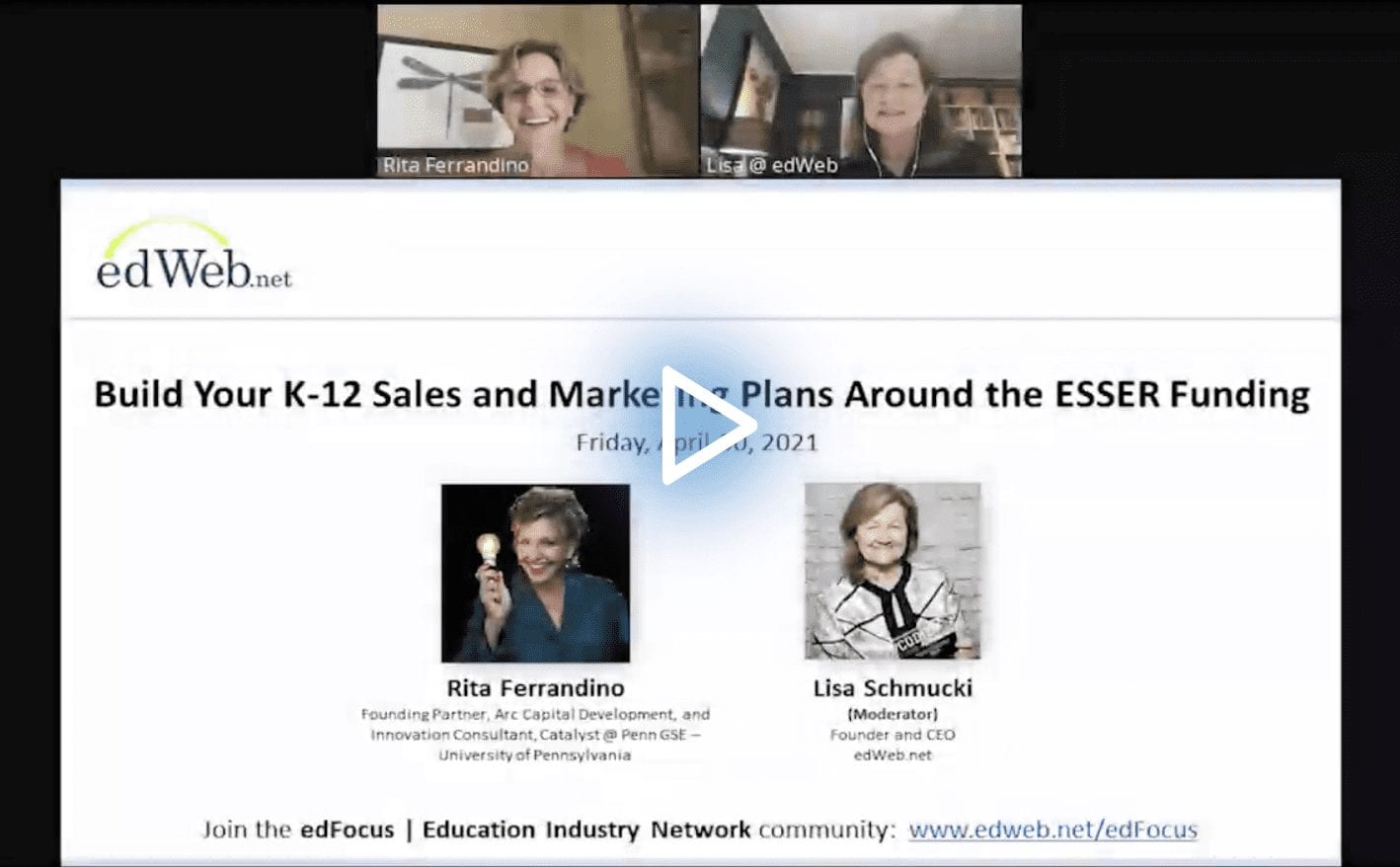Education Stimulus Funding: The Who, What, and Why
By Stacey Pusey
News about economic stimulus funding for K-12 education brought a lot of excitement, confusion, and questions for both vendors and school districts. Who gets the money? How much and how is it distributed? Where can it be spent? During an edFocus Friday edWebinar, “Build Your K-12 Sales and Marketing Plans Around the ESSER Funding,” Rita Ferrandino, Founding Partner at Arc Capital Development and Innovation Consultant at Catalyst @ Penn GSE – University of Pennsylvania, explained the purpose of the three rounds of stimulus funding and how they could impact education companies.
CARES Act (Mar. 25, 2020)
This first round of funding came as the pandemic and stay-at-home orders hit, which impacted projected state revenues. As the majority of school funding comes from state and local governments, the lost revenue could seriously hurt school funding. Thus, of the $30.7 billion designated for education, only $13.2 billion went to the Elementary and Secondary School Emergency Relief Fund (ESSER). The money, allocated based on the existing Title I funding formula, was meant as a stopgap to help states with the financial cycle and nothing more. In addition, legislation included the Governor’s Emergency Education Relief Fund (GEER), which gave states an additional $3 billion to assist Title I students.
Coronavirus Response and Relief Supplemental Appropriations Act (Dec. 27, 2020)
As the first round of stimulus wasn’t enough to make up the funding gap, this second round included more money for both ESSER ($54 billion) and GEER ($4 billion). While the money is still allocated through the Title I formula, this time, there is a reporting requirement. States must document that they’re using the money to address learning loss. There are opportunities here for assessment companies.
American Rescue Plan Act (Mar. 11, 2021)
In the third round, the federal government made its largest contribution to K-12 education: $130 billion to be spent by 2024. But this money isn’t meant to make up budget deficits. In fact, in order to receive the funding, states cannot spend less on high-poverty populations, and they can’t cut higher education and K-12 spending below 2017, 2018, and 2019 levels. In other words, this money could be an opportunity for vendors. However, like the second stimulus funding, there are reporting requirements. Districts must use the money on evidence-based programs that help stem learning loss, close the digital divide, and address social and emotional learning needs. Since the funding is using the same formulas as current ESEA programs, schools can purchase products already allowed under federal programs like IDEA, Title I, ESEA, Perkins Act, etc.
Ferrandino cautioned, though, that while the third round of funding might make it seem like states and districts are flush, there are a few things to keep in mind.
- These are grants with a set life cycle. The extra funding won’t last forever, so schools will be cautious.
- Similarly, because of the reporting requirements associated with the funding, potential purchases will undergo additional scrutiny.
- Of course, vendors shouldn’t use stimulus money as the main angle in marketing and sales materials. Instead, they should always set themselves up as a solutions provider and talk about how they can help districts with a specific problem. (This means they have to do their research on each district ahead of time.)
- Finally, the influx of money is causing states and districts to retool their strategic plans. Companies should look at state education departments’ and districts’ websites to find out how they are changing their strategic plans and where the company’s products could help.
This broadcast was hosted by edWeb.net.
About the Presenter
Rita Ferrandino has built an international reputation as one of the most effective strategists and coalition builders in the education entrepreneurship community. She is a recognized STEM education expert, an authority on U.S. education policy and politics, and a leader in Future of Work strategies. Rita is the founding partner at Arc Capital Development, a global private investment and advisory firm. Arc invests in, operates and advises companies in the education and corporate training markets and has served over 150 clients in the U.S., Australia, Canada, Mexico, Singapore, Hong Kong, China, Ireland, Turkey, Israel and India. Arc clients and portfolio companies provide products generating over a billion dollars a year worldwide. Rita’s career highlights include being Salesperson of the Year at Pearson Education for three consecutive years, selling more than $178 million of products to the higher education and K-12 markets, leading the acquisition effort for more than 50 STEM titles, and forming revenue-producing alliances with more than a dozen of the industry’s largest publishers and distributors. She has been responsible for double-digit sales growth for at least six years at two different major publishers. Rita currently is the innovation consultant at the Catalyst @ Penn GSE Innovation Center at the University of Pennsylvania’s Graduate School of Education. She was the lead capstone instructor at the Education Entrepreneurship Graduate Program for four years. For three years, she was President of the Education Design Studio, Inc. incubator funded in collaboration with the Milken Family Foundation and University of Pennsylvania.
About the Moderator
Lisa Schmucki is the founder and CEO of edWeb.net. Lisa is an education, publishing, and media industry veteran with 40 years’ experience in product development, professional learning, marketing, and entrepreneurship. Lisa has served on the Board of the SIIA Education Technology Industry Network and is on the Advisory Council for the ERDI Alliance for Education Impact. She is a graduate of Princeton University and has a master’s degree from the Stern School of Business at NYU.
edFocus | Education Industry Network is a free professional learning community on edWeb.net that will help you connect with colleagues in the education industry to share information and resources, raise questions, and get advice.
Stacey Pusey is an education communications consultant and writer. She assists education organizations with content strategy and teaches writing at the college level. Stacey has worked in the preK-12 education world for 20 years, spending time on school management and working for education associations including the AAP PreK-12 Learning Group. Stacey is working with edWeb.net as a marketing communications advisor and writer.




Comments are closed.